Polished cement: what are the advantages and disadvantages?
Polished concrete is a type of coating that comes from the industrial field but the evolution of trends in the sector has made it extend its application range. This is due to the properties it has, among which stand out a solid but aesthetic appearance at the same time and a very high traffic resistance.
Thanks to these, it has extended, increasingly, among homes and offices although it continues to be widely used in parking lots or factories. After all, who doesn't want floors with a modern style and resistant?
But here we find one of its handicaps: that it can only be applied on pavements. Anyway, we are going to analyze it in depth, detailing its advantages and disadvantages, so that you understand what it can contribute to each space, or if, on the other hand, there are other materials that adapt better.
Firstly, what is polished cement
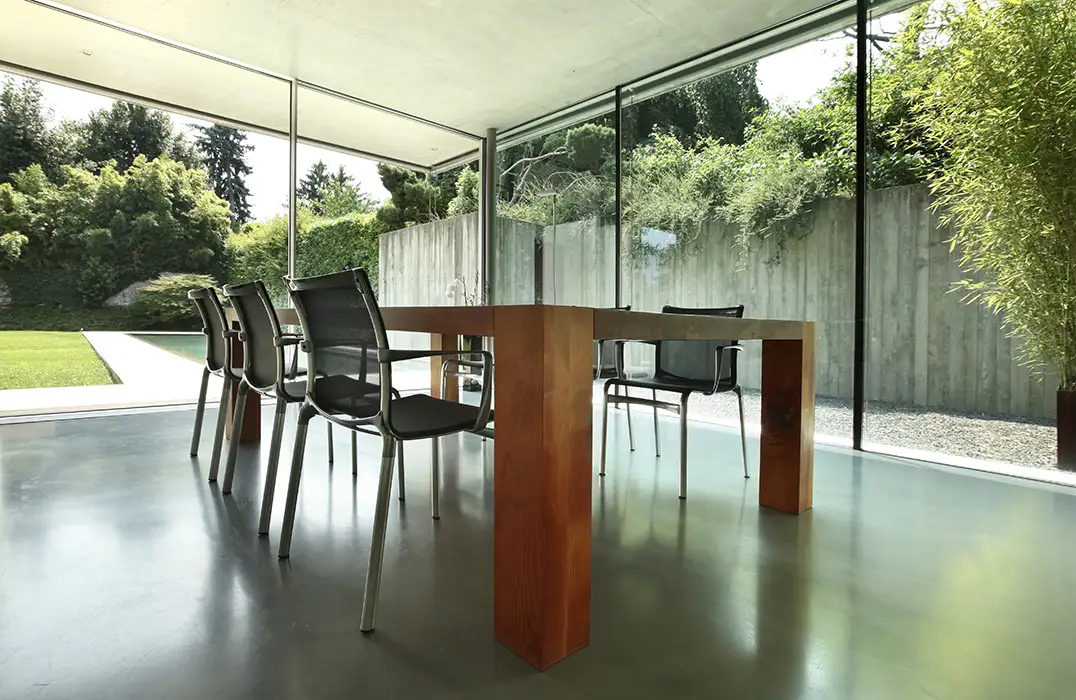
Dining room overlooking the garden in which the floor has been finished with polished cement.
Firstly, what is polished cement
Polished cement is a material becoming ever more popular in both interior and exterior decoration. It is a finishing technique for concrete surfaces that is characterized by its smooth, uniform, and shiny appearance. For its malleability experience, a mechanical polishing process with special diamond tools is used which removes the top layer of the concrete and reveals the aggregate and cement paste underneath.
Polished concrete is made up of the same materials as conventional concrete: Portland cement, sand, water, and aggregates. However, it is used in a different proportion to achieve greater strength and durability. In addition, special additives are added to improve the manageability, strength, and durability of the material.
This type of cement has historically been used on surfaces exposed to high and heavy traffic, such as in industrial warehouses, car parks, and sports facilities. However, currently, its use has extended to a wide variety of applications, from restaurants and commercial premises, interior floor and wall surfaces, to exteriors, and building facades.
One of the main advantages of polished concrete is its high resistance to wear, abrasion, and compression, making it especially suitable for high traffic areas. In addition, it is resistant to stains and is easy to clean and maintain.
Polished concrete has become a popular option for modern and minimalist interior design due to its smooth and uniform appearance. As a decorative covering, it is applied directly to the floor creating a continuous and modern finish, making it a great ally for achieving rooms that breathe contemporaneity and avant-garde.
It is important to bear in mind that polished concrete requires a careful installation process and specific maintenance to minimize the risk of fracture. Therefore, it is essential that this type of work is carried out by professionals who have the experience and necessary skills to guarantee a quality result.
How is polished concrete made?
Polished concrete is a very versatile material that is used in multiple applications due to its high resistance and durability. From its use in interior and exterior pavements, to wall coverings, stairs, or kitchen and bathroom countertops, polished concrete has become a very popular option in the world of construction and decoration.
Although it is characterized by the ease with which its ingredients blend, it is important to highlight that to achieve an optimal mix it is necessary to have a professional concrete mixer. The help of this machine is crucial to achieve a homogeneous mass among sand, aggregates, cement, and water.
The use of a concrete mixer also guarantees the uniformity of the mix, avoiding the presence of irregularities and possible defects in the final surface. Furthermore, its use reduces the preparation and transportation time of the mix, which translates into greater efficiency on the job.
The mix of the polished cement can be made in situ, that is, in the same place where the application is going to be carried out. This immediacy facilitates the preparation, transportation, and coating tasks, reducing the risk of errors in the process.
It's important to highlight that, even though polished cement is strong and durable, its maintenance is key for its long-term preservation. For this, a regular cleaning is recommended, as well as the use of specific products that won't harm the surface.
In conclusion, polished cement is a material that offers multiple advantages and possibilities in the world of construction and decoration. Its easy mixing, resistance and durability, along with proper maintenance, ensure a high-quality and customer satisfying final result. The use of a professional concrete mixer for the mix, as well as performing proper cleaning and maintenance, are crucial to ensure its correct application and durability.
How to apply polished cement on floors?
Polished cement is a material highly demanded in floor construction nowadays. It is chosen by many people due to its elegant, modern and minimalist look, as well as its durability. Its application requires a rigorous and well-planned process to guarantee a perfect finish.
1- Floor Preparation
Before applying polished cement, the application area and its surroundings must be thoroughly cleaned. This includes the elimination of any dirt and the removal of objects that can obstruct the application process.
After the surface is cleaned, it's proceeded to formwork the base so that the concrete can be poured onto it. This process is very important because it ensures the stability of the structure. The duration of the formwork process depends on the surface to be treated, the larger the surface, the longer the duration.
2- Formwork
After cleaning and preparing the soil, it's necessary to proceed to the formwork of the base so that the concrete can be poured onto it. The formwork is a structure that surrounds and delimits the area where the concrete is going to be poured, and it can be made of different materials such as wood or metal.
The formwork must be completely level to ensure that the surface of the ground is uniform after the concrete has been poured. In addition, it's important for the formwork to have the proper height so that the layer of concrete has the desired thickness. In general, it is recommended that the formwork has a thickness of about 10 cm so that the layer of concrete has the necessary strength.
3- Placement of the mesh
The placement of the mesh is a fundamental step in the application of polished cement. The mesh is a steel wire network that is placed on the base to increase the strength and stability of the surface.
It’s important that this step is performed by professionals, who will determine if it’s necessary or not the placement of the mesh, depending on the surface and the use that will be given to the soil.
4- Concrete pour
Once the base is formworked and the mesh is placed, the concrete is poured. It's essential that the concrete mixture is homogeneous to get the best results. Once the concrete is poured, the surface is smoothed and leveled. To do this, an aluminum rule is used, with which the concrete is spread and smoothed.
It is important to keep in mind that the drying time of the concrete will depend on the weather conditions and the amount of moisture in the environment. Therefore, it is recommended to wait at least a couple of days to ensure that the concrete is completely dry before continuing with the next step.
5- Smoothing
Smoothing is the final step in applying polished cement. Once the concrete is completely dry, a polishing machine equipped with diamond discs is used to polish and smooth the surface.
It is important that this step is carried out by professionals, as the polishing process is very delicate and any mistake can ruin all the previous work. It is advisable to pass the machine several times over the surface to achieve the desired shine and the smooth and uniform finish that is sought.
In conclusion, the application of polished cement requires a rigorous and well-planned process, from the preparation of the surface to the final smoothing. Each step is important and must be performed by professionals to ensure the desired final result. A well-applied polished concrete floor is a durable and elegant investment, which will provide a resistant and easy-to-maintain surface over time.
Polished cement is a material for indoor and outdoor use
Its qualities make polished cement an ideal material for interiors. Despite its industrial appearance, it creates pleasant environments and fills rooms with warmth. In addition, its resistance to traffic plays a fundamental role here, making it a long-lasting flooring, regardless of the environmental conditions it has to withstand.
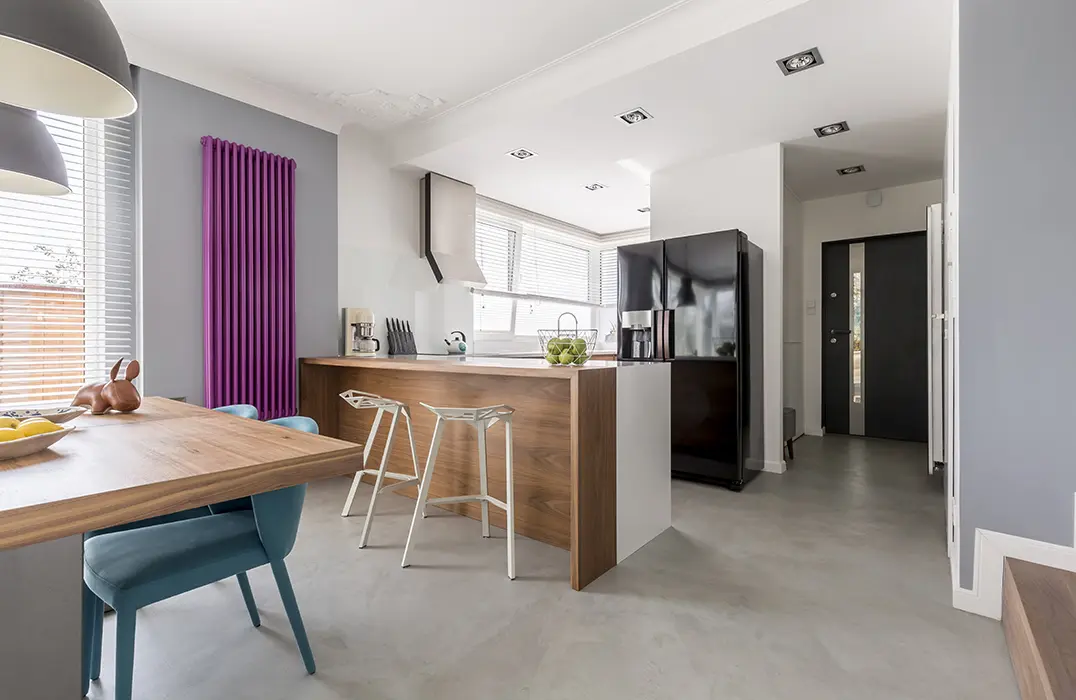
Open kitchen to the dining room whose floor has been covered with polished cement.
Polished cement knows no limits when it comes to interiors and exteriors, as its use is much more widespread in internal areas, thanks to its resistance and durability it is more than suitable to apply in external spaces. This versatility has led it to become a leading construction technique in recent times.
Polished cement in industrial floors
As we previously mentioned, in its early days, polished cement became the flooring par excellence of industrial places. Thus, it was (and still is) very common to find it in car parks, warehouses, parking lots, shopping centers or supermarkets. This was because it could withstand any car, van, truck, heavy machinery or large numbers of people passing over it.
Thus, over time and without abandoning its industrial origin, it began to become a more recurrent technical and decorative trend for covering spaces in the domestic environment.
Polished concrete in domestic floors
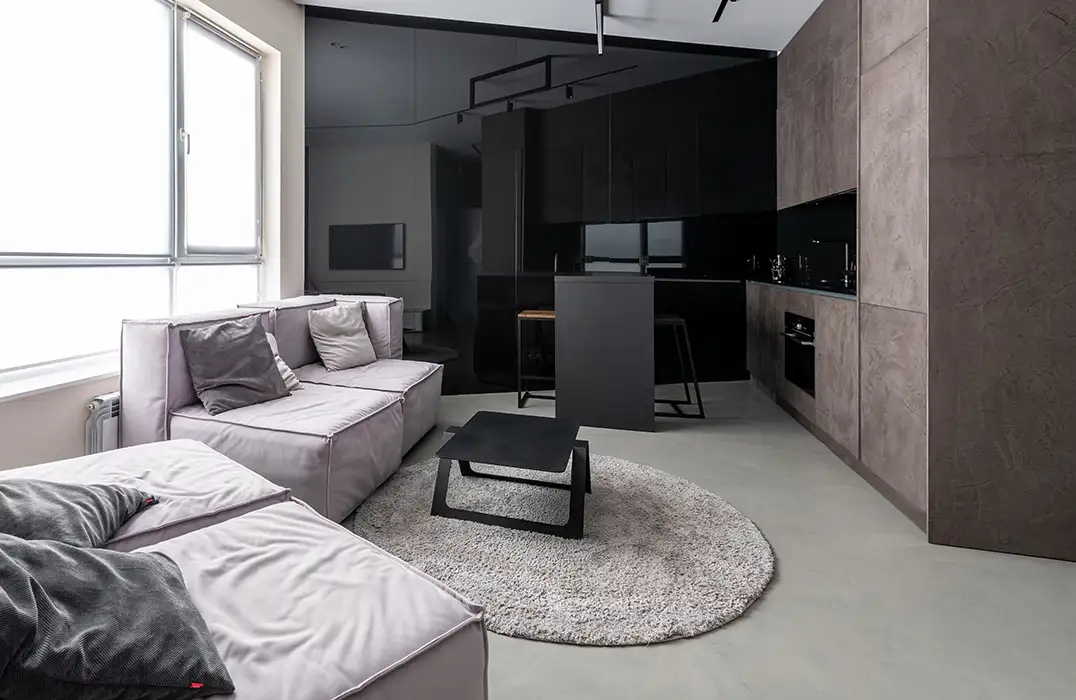
Kitchen open to the living room whose floor has been covered with polished concrete.
The evolution of polished concrete has shifted towards home cladding. Thus, its use can transform homes into more comfortable places. Its rough or rustic appearance began to conquer the taste of professional architects and interior designers to contribute all and each one of its attributes to more personal spaces.
In this way, it is increasingly used as flooring for entire homes or individual rooms. Bedrooms, living rooms, bathrooms, kitchens, no space is excluded from the charms of this material.
Advantages of floors covered with polished concrete
Polished concrete is a material that has gained much popularity in recent years due to its countless benefits.
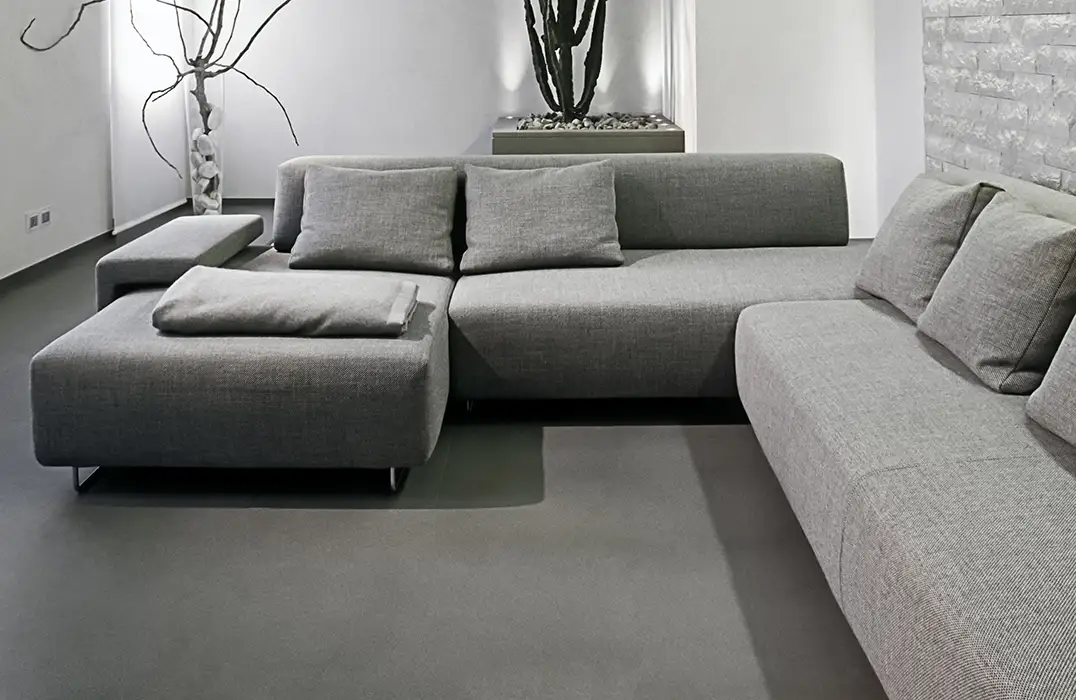
Minimalist living room whose floor has been covered with polished concrete.
Great durability and resistance
Among them, its great durability and resistance stand out, making it ideal for high traffic areas, such as public building hallways or loading and unloading areas in industrial warehouses.
Additionally, this material is highly resistant to tire rolling, making it an ideal option for garage or warehouse floors. Its ability to withstand heavy loads without damage makes it especially suitable for industrial and commercial environments.
Easy to clean
Another great advantage of polished concrete is its ease of cleaning. Its smooth surface prevents the accumulation of dust and dirt, resulting in easy and quick cleaning. Consequently, this material is a good choice for those spaces that require constant cleaning, such as hospitals, clinics, and schools.
Provides a sense of spaciousness
In addition to being easy to clean, polished concrete floors provide a sense of spaciousness to any space. Its smooth and uniform surface gives the impression that the room is larger than it really is. This feature is especially useful in small spaces, such as apartments or commercial establishments, where space is limited. Furthermore, polished concrete floors have a modern and elegant finish that adapts to any decorative style.
Compression resistance
Another benefit of polished concrete is its resistance to compression. This material is able to withstand large amounts of weight without suffering structural damage. That is why polished concrete floors are a good option for any space that requires high compression resistance, such as industrial and commercial facilities.
Drawbacks of a material like polished concrete
Whilst it is true that polished concrete has advantages that make it an option to consider seriously for floor coverings, it also has some drawbacks that could lead us to choose another type of material for covering pavements.
Its initial shine does not last forever
As mentioned above, polished concrete shows an impressive initial shine that fades over time. This is a problem that cannot be solved with a simple cleaning, but requires a complete restoration of the pavement to return to its original aspect.
Therefore, if you want the polished concrete to maintain its shiny appearance, it is important to consider that regular maintenance will be necessary.
Needs help from specific machinery
The installation of a high-quality polished concrete floor largely depends on the equipment used for its application and maintenance.
Utilizing manual tools to apply the concrete does not guarantee a uniform or long-lasting finish, so investing in specialized machinery becomes necessary. However, this investment can be expensive for some projects, making polished concrete not the most suitable option in certain cases.
Limited insulating capacity
Polished concrete is not the most suitable material to improve sound and thermal insulation indoors. Although special treatments can be applied to improve these properties, their effectiveness is limited. Therefore, if insulation is an important factor for your project, you may need to consider other flooring options.
Has expansion joints
Polished concrete requires the installation of expansion joints to prevent it from cracking over time. Although these joints are necessary, they often become visible and can break the uniformity of the pavement. In addition, dirt can accumulate in these joints, which can make cleaning difficult and reduce the longevity of the flooring.
High thermal sensitivity
Polished concrete is sensitive to thermal variations, which can cause cracking on the surface. This is especially true in extreme climates, where temperatures can vary significantly during the day. If your project is located in an area with extreme temperature changes, you may need to consider other flooring options.
It is very heavy
Polished concrete is a heavy material, which can be problematic in certain situations. For example, if you want to install polished concrete on an upper floor, you should check that the building can bear the additional weight. Moreover, the weight of polished concrete makes its application more complicated and requires more time and resources than other covering materials.
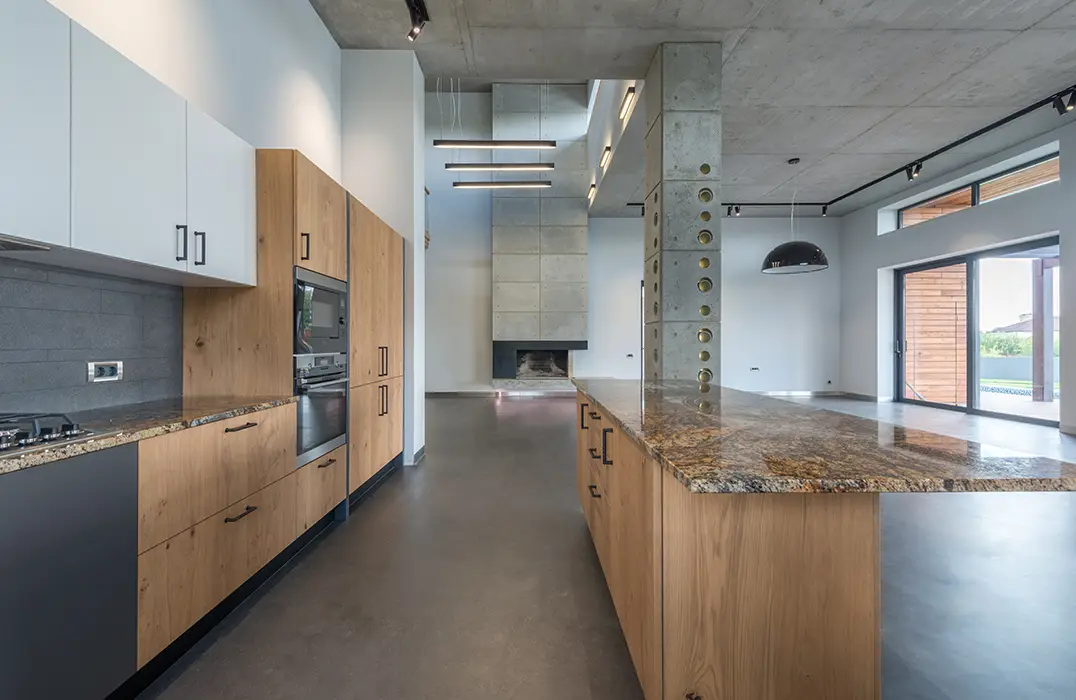
Kitchen with wooden furniture whose floor has been coated with polished concrete.
How much does polished concrete cost per square meter?
If we guide ourselves by intuition and stick to the degree of use of this material, which is increasingly used in any type of space, we might think that polished concrete has a very good quality/price ratio.
We are not saying the contrary, but this, as in any case of coating application where not only the material itself is involved, depends on other external factors.
Decisive factors in determining its price
In addition to the size of the surface to be applied, there are many other variables that intervene in the final price calculation of a polished cement construction. In this case, it's clear: the more square meters to cover, the greater the amount to pay.
Another aspect to take into account is the location of the area where the material is intended to be applied since if it is located in outdoor areas it can increase the final amount as it often presents conditions of temperature and humidity that can hinder the tasks, or may require specific treatments.
The finishes. Let's not forget that polished cement, as its name suggests, needs to be smoothed out in a compulsory manner. This process directly affects the finish that is intended to be achieved and, to achieve it, it is imperative to have machinery that will allow us to obtain the desired shine.
Finally, its price, which we cannot determine exactly since this can depend on the rates of the professional in question who is going to be in charge of the work. Even so, and as an estimate, the cost of the material ranges between 40 and 50 €.
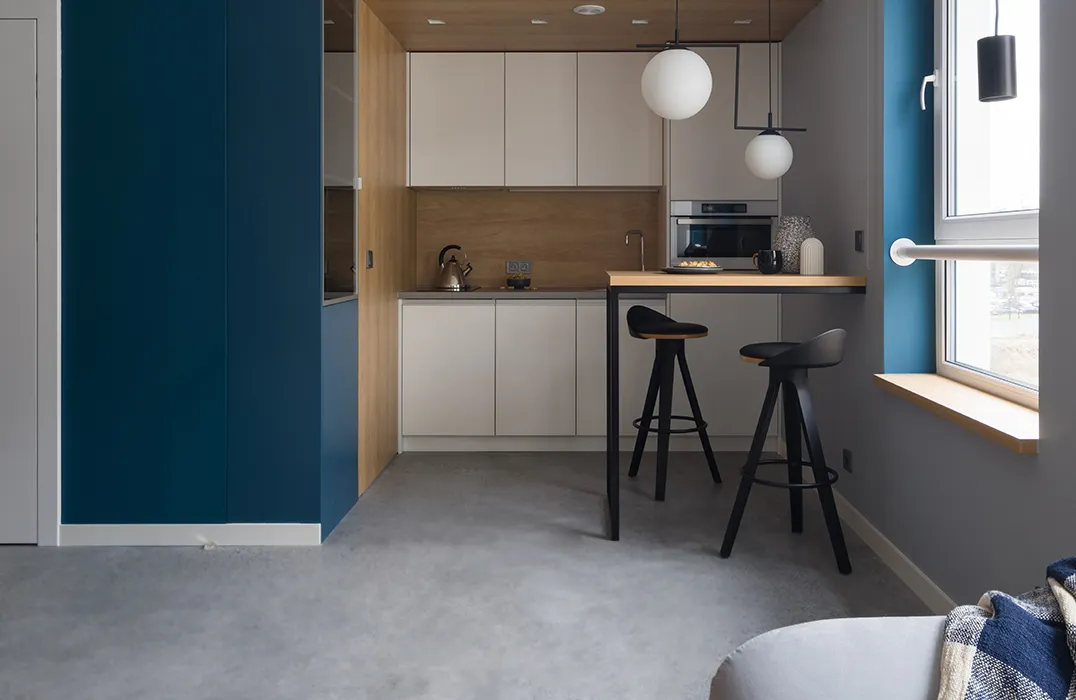
Small kitchen whose floor has been coated with polished cement.
Microcement: an alternative to polished cement for floors and other surfaces
As we mentioned earlier, due to its weight, polished cement can only be applied on horizontal surfaces and low height such as floors. And although in these it does respond satisfactorily to aesthetic and technical expectations, its use, in general, is quite limited.
On the other hand, microcement, much lighter thanks to its thickness of 3 mm, can be applied on any type of surface no matter if it is vertical, horizontal or if it is located inside or outside.
Ultimately, microcement is a continuous decorative coating with a series of advantages unattainable for polished cement as it not only does not generate joints but it is stronger, more durable, easier to apply, more versatile and with greater decorative aptitudes as it allows to be easily mixed with any color.
If you want to know more about another floor coating, we recommend that you discover our microcement for floors.